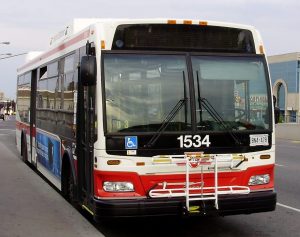 It is widely known that America’s infrastructure is in desperate need of repair, rehabilitation, and replacement, and that the American Society of Civil Engineers (ASCE) gave water and wastewater infrastructure a “D” grade in its 2013 report card. Contributing to the decline of our buried infrastructure is a combination of aging assets, increasing demand, and decreasing funding. However, America is not alone. Our neighbors to the north are also experiencing an infrastructure crisis and, like the United States, are working together to develop short-term and long-term strategies to ensure that its critical infrastructure continues to successfully function well into the future.
It is widely known that America’s infrastructure is in desperate need of repair, rehabilitation, and replacement, and that the American Society of Civil Engineers (ASCE) gave water and wastewater infrastructure a “D” grade in its 2013 report card. Contributing to the decline of our buried infrastructure is a combination of aging assets, increasing demand, and decreasing funding. However, America is not alone. Our neighbors to the north are also experiencing an infrastructure crisis and, like the United States, are working together to develop short-term and long-term strategies to ensure that its critical infrastructure continues to successfully function well into the future.
The 2016 Canadian Infrastructure Report Card
Four organizations — the Canadian Construction Association (CCA), the Canadian Public Works Association (CPWA), the Canadian Society for Civil Engineering (CSCE), and the Federation of Canadian Municipalities (FCM) — came together to assess the health of Canada’s infrastructure. The resulting report, Informing the Future: The 2016 Canadian Infrastructure Report Card (2016 CIRC), provides information to policymakers and stakeholders regarding the state of Canada’s infrastructure and what is needed to maintain and improve it. Additional support for the project came from the Canadian Urban Transit Association, the Federal-Provincial/Territorial Sport, Physical Activity and Recreation Committee, and the Canadian Parks and Recreation Association. One of the overarching goals of the assessment is to ensure the sustainability of the high quality of life that infrastructure brings to the Canadian people. Infrastructure evaluated included water, wastewater, and stormwater infrastructure as well as roads and bridges, buildings, public transit, and recreational facilities.
A key finding in the 2016 CIRC is that over one-third of Canada’s municipal infrastructure is in fair, poor, or very poor condition, and at risk of rapid decline. To prevent this deterioration, investment in the maintenance and repair of failing infrastructure is critical in the short-term. The report also noted that despite the efforts of municipal governments, reinvestment rates in municipal infrastructure are falling behind — a trend which will cause an exponential increase in the overall cost for infrastructure repair and rehabilitation if left unchecked.

Because resources are limited, strategic investment into those assets most in need of repair or replacement is paramount. However, a surprising number of Canadian municipalities, particularly smaller systems, lack any type of formal asset management plan. The 2016 CIRC survey results indicate that 62% of large municipalities, 56% of mid-sized municipalities, and only 35% of small municipalities reported having a formal asset management plan in place. And while all communities benefit from an asset management plan that prioritizes capital investment, small municipalities that admittedly have the least amount of resources would likely benefit the most. Additional findings of the report indicate that climate change is not consistently being factored into the decision-making processes of municipalities, and that most municipalities also do not utilize computer-based information to manage and maintain their assets.
The Federal Gas Tax Fund
As part of the New Building Canada Plan, the renewed federal Gas Tax Fund (GTF) was announced in the Economic Action Plan 2013 as a long-term, stable source of funding for municipal infrastructure. Implemented as a means of addressing the infrastructure funding gap, the Gas Tax Fund will provide $10.4 billion to Canada’s municipalities between 2014 and 2018. Because Canada recognizes the criticality of an up-to-date asset management plan, the renewed GTF prioritizes long-term capital planning and asset management. For example, Ontario municipalities will receive $3.8 billion from the GTF between 2014 and 2018, more than any other province; the Association of Municipalities Ontario (AMO) has made the receipt of those funds contingent upon adherence to a new policy. Ontario municipalities are required to develop and implement an asset management plan by December 31, 2016 in order to continue to receive federal GTF payments.
Investing in Canada
Fortunately, Canadians recognize the importance of infrastructure to their way of life and are committed to investing in infrastructure and bridging the infrastructure gap both now and in the future. Budget 2016 saw the newly elected Canadian government, focused on strengthening the middle class, show its firm commitment to Canada’s future growth by making an immediate investment of $11.9 billion into green and social infrastructure as well as public transit. The Fall Economic Statement, released on November 1, 2016, further strengthens that commitment by promising an additional $81.2 billion investment into Canadian infrastructure over 11 years, as follows:
-

Toronto Transit Commission public transit bus in Toronto, Ontario, Canada Public Transit: Faster Commutes and Innovative Communities—$25.3 Billion
Public transit infrastructure investments will have a greater focus on new, transformative construction and expansion projects that build the transit systems of the 21st century.
- Green infrastructure: Clean Air, Clean Water—$21.9 Billion
The federal government will work with its provincial, territorial, municipal, and Indigenous partners to evaluate, select, and fund the green infrastructure projects that will deliver the best outcomes for Canadians.
- Social Infrastructure: Better Neighborhoods for Our Kids—$21.9 Billion
Investments in social infrastructure will focus on affordable housing and homelessness prevention, early learning and child care, and cultural and recreational infrastructure.
- Getting Canadian Products to Global Markets—$10.1 Billion
The government will make strategic investments in trade and transportation projects that build stronger, more efficient transportation corridors to international markets and help Canadian businesses to compete, grow, and create more jobs for Canada’s middle class.
- Rural and Northern Communities—$2 Billion
Through Investing in Canada, the government will provide up to $2 billion to support small, rural, and northern communities with a wide range of infrastructure needs.

Considering existing infrastructure programs, new investments made in Budget 2016, and the additional investments detailed in the Fall Economic Statement, the Canadian government has committed to investing over $180 billion into its critical infrastructure over the next decade.
The Canada Infrastructure Bank
The Canadian government has also announced that it is launching the new Canada Infrastructure Bank to provide low-cost financing and small capital contributions for necessary infrastructure projects. $35 billion has been earmarked for large infrastructure projects that directly contribute to economic growth, $15 billion of which will be sourced from the previously announced funding for green and social infrastructure, public transit, trade and transportation, and rural and northern communities. The remaining $20 billion will be available to the Bank for investments that result in the Bank holding assets in the form of equity or debt, and will therefore have no fiscal impact on the government.
In Conclusion
Much of Canada’s infrastructure, like our own here in America, is reaching the end of its useful life and is in desperate need of repair or replacement. The Canadian people and government recognize that infrastructure plays a critical role in maintaining the high quality of life to which Canadians are accustomed. Through increased asset management, targeted investment, a committed government, and a long-term, sustainable plan, Canada is well positioning itself for future growth and prosperity.
